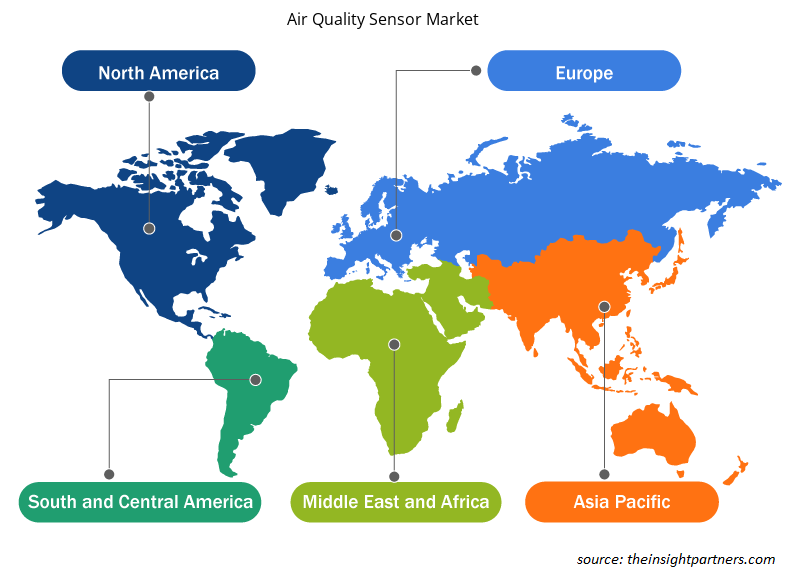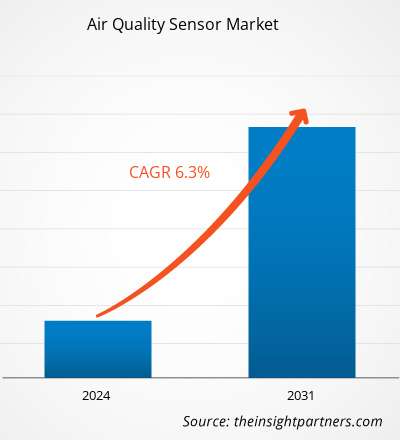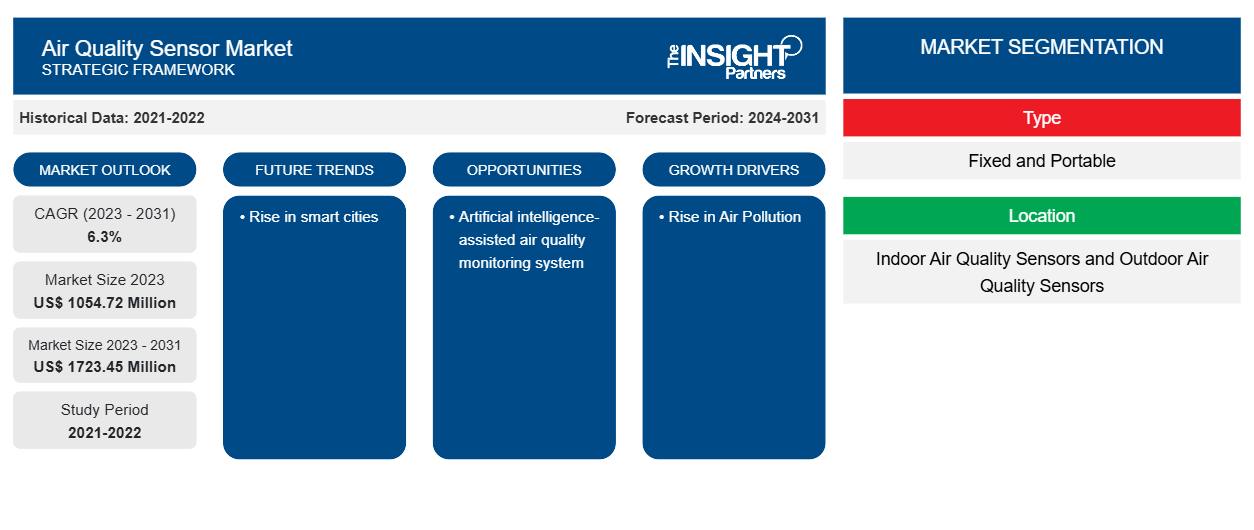공기질 센서 시장 규모는 2023년 10억 5,472만 달러에서 2031년 17억 2,345만 달러로 증가할 것으로 예상됩니다. 이 시장은 2023~2031년에 6.3%의 CAGR을 기록할 것으로 예상됩니다. 증가하는 대기 오염과 정부의 지속 가능성에 대한 집중은 공기질 센서 시장의 주요 트렌드로 남을 가능성이 높습니다.
공기질 센서 시장 분석
증가하는 환경적 우려와 공기 질을 모니터링하기 위한 정부의 엄격한 규제는 공기 질 센서 시장 채택으로 이어지고 있습니다. 깨끗한 공기의 중요성과 공기 중 질병의 단점에 대한 인식이 커지면서 다양한 산업에서 채택이 촉진되고 있습니다. 친환경 산업 개발을 위한 정부 이니셔티브는 시장 성장을 더욱 촉진합니다.
공기질 센서 시장 개요
공기질 센서는 공기 중 오염 물질의 농도를 측정하는 장치입니다. 공기 청정기 와 신선한 공기 시스템의 필수 구성 요소입니다. 공기질 센서는 일반적으로 미세먼지(예: pm1, pm2.5, pm10), 가스(예: 오존, 일산화탄소, 이산화탄소, 메탄, 포름알데히드 등) 및 일부 환경 지표(예: 온도, 습도, 자외선, 조명 등)를 측정할 수 있습니다. 공기질 센서는 광학, 전기, 열 및 기타 방법을 사용하여 공기 중의 가스 및 미세먼지 지표를 감지합니다.
귀하의 요구 사항에 맞게 이 보고서를 사용자 정의하세요
이 보고서의 일부 또는 국가 수준 분석, Excel 데이터 팩을 포함하여 모든 보고서에 대한 사용자 정의를 무료로 받을 수 있으며 신생 기업 및 대학을 위한 훌륭한 혜택과 할인 혜택을 이용할 수 있습니다.
-
이 보고서의 주요 시장 동향을 알아보세요.이 무료 샘플에는 시장 동향부터 추정 및 예측까지 다양한 데이터 분석이 포함됩니다.
공기질 센서 시장 동인 및 기회
대기 오염 증가로 시장이 유리해진다
산업화가 진행됨에 따라 미세먼지와 같은 독소가 추가되면서 대기 오염이 증가했습니다. 여러 국가의 정부는 각자의 지역에서 엄격한 규제를 시행하고 산업 현장에서 발생하는 대기 오염을 완화하기 위한 다양한 조치를 고안했습니다. 또한 미국, 인도, 캐나다를 포함한 여러 국가의 정부는 발전소, 석유 및 가스, 자동차에 대기 질 센서를 설치하여 오염 수준을 관리하고 추적합니다. 공장은 실외 대기 질 모니터링을 사용하여 산업 단위 주변의 대기 질 지수를 주시함으로써 배출률을 제어할 수 있습니다.
공기질 센서의 이점
전 세계적으로 환경 문제가 커지면서 환경에 미치는 영향을 최소화하기 위한 특정 조치를 취하기 위해 지속적으로 공기 질을 모니터링해야 할 필요성이 커지고 있습니다. 따라서 공기 질 감지 기술에 대한 수요는 여러 가지 이점으로 인해 증가하고 있습니다. 실내/실외 공기 상태를 실시간으로 모니터링하여 건강한 환경을 조성하는 데 도움이 됩니다. 공기 질 센서는 설치가 쉽고 모바일 및 컴퓨터에 쉽게 연결하여 공기 질 결과를 표시합니다. 온도, 기압, 습도 등 광범위한 매개변수를 감지할 수 있습니다. 지속적인 기술 발전으로 이러한 센서의 정확도가 향상되어 정부 기관 및 학술 기관, 상업 및 주거 사용자, 석유 화학 산업, 발전소, 제약 산업, 스마트 시티 당국 등 광범위한 산업의 여러 업체에서 수요가 증가하고 있습니다. 따라서 이러한 수요에 부응하기 위해 시장 참여자는 공기 질 센서 시장을 주도하는 솔루션을 출시합니다. 예를 들어, 2021년 6월 Vaisala는 지역 사회의 삶의 질, 안전, 효율성 및 지속 가능성을 향상시키기 위해 모니터링 솔루션을 보완하는 세계적 수준의 공기 질 센서를 출시했습니다.
공기질 센서 시장 보고서 세분화 분석
공기 질 센서 시장 분석에 기여한 주요 세그먼트는 유형, 위치 및 최종 사용자입니다.
- 유형별로 시장은 고정형과 휴대용으로 세분화됩니다. 고정형 공항 세그먼트는 2023년에 더 큰 시장 점유율을 차지했습니다.
- 위치별로 시장은 실내 공기질 센서와 실외 공기질 센서로 세분화됩니다. 실외 공기질 센서 세그먼트는 2023년에 시장에서 가장 큰 점유율을 차지했습니다.
- 최종 사용자별로 시장은 정부 기관 및 학술 기관, 상업 및 주거 사용자, 석유화학 산업, 발전소, 제약 산업, 스마트 시티 당국 등으로 세분화됩니다. 정부 기관 및 학술 기관 부문은 2023년에 시장에서 가장 큰 점유율을 차지했습니다.
지역별 공기질 센서 시장 점유율 분석
공기 질 센서 시장 보고서의 지리적 범위는 주로 북미, 아시아 태평양, 유럽, 중동 및 아프리카, 남미/남중미의 5개 지역으로 나뉩니다.
수익 측면에서 아시아 태평양 지역은 2023년 가장 큰 공기질 센서 시장 점유율을 차지했습니다. 이 지역은 인도, 일본, 중국 등과 같은 선진국과 개발도상국으로 구성되어 있으며, 깨끗하고 안전한 환경을 위해 이러한 센서에 대한 수요가 증가하고 있습니다. 이러한 센서를 사용하는 것의 이점에 대한 인식이 높아짐에 따라 시장 성장이 촉진되었습니다. 또한 이 지역의 정부 기관은 이러한 센서 개발에 집중하고 있으며, 이는 시장 성장을 더욱 촉진합니다. 예를 들어, 2023년 1월 MeitY는 MeitY 지원 프로젝트에서 개발한 공기질 모니터링 시스템 기술(AI-AQMS v1.0)을 출시했습니다. 콜카타의 첨단 컴퓨팅 개발 센터(C-DAC)는 TeXMIN, ISM, Dhanbad와 협력하여 '농업 및 환경에서의 전자 및 ICT 응용 프로그램(AgriEnIcs)에 관한 국가 프로그램'에 따라 PM 1.0, PM 2.5, PM 10.0, SO2, NO2, CO, O2, 주변 온도, 상대 습도 등의 환경 오염 물질을 모니터링하는 실외 공기 질 모니터링 스테이션을 개발하여 환경의 공기 질을 지속적으로 분석합니다.
공기질 센서 시장 지역 통찰력
Insight Partners의 분석가들은 예측 기간 동안 공기질 센서 시장에 영향을 미치는 지역적 추세와 요인을 철저히 설명했습니다. 이 섹션에서는 북미, 유럽, 아시아 태평양, 중동 및 아프리카, 남미 및 중미의 공기질 센서 시장 세그먼트와 지리에 대해서도 설명합니다.

- 공기질 센서 시장을 위한 지역별 특정 데이터 얻기
공기질 센서 시장 보고서 범위
| 보고서 속성 | 세부 |
|---|---|
| 2023년 시장 규모 | 10억 5,472만 달러 |
| 2031년까지 시장 규모 | 17억 2,345만 달러 |
| 글로벌 CAGR (2023-2031) | 6.3% |
| 역사적 데이터 | 2021-2022 |
| 예측 기간 | 2024-2031 |
| 다루는 세그먼트 |
유형별로
|
| 포함된 지역 및 국가 |
북아메리카
|
| 시장 선도 기업 및 주요 회사 프로필 |
|
공기질 센서 시장 참여자 밀도: 비즈니스 역학에 미치는 영향 이해
공기질 센서 시장은 소비자 선호도의 변화, 기술 발전, 제품의 이점에 대한 인식 증가와 같은 요인으로 인해 최종 사용자 수요가 증가함에 따라 빠르게 성장하고 있습니다. 수요가 증가함에 따라 기업은 제품을 확장하고, 소비자의 요구를 충족하기 위해 혁신하고, 새로운 트렌드를 활용하여 시장 성장을 더욱 촉진하고 있습니다.
시장 참여자 밀도는 특정 시장이나 산업 내에서 운영되는 회사나 기업의 분포를 말합니다. 주어진 시장 공간에 얼마나 많은 경쟁자(시장 참여자)가 존재하는지 그 규모나 총 시장 가치에 비해 나타냅니다.
공기질 센서 시장에서 활동하는 주요 회사는 다음과 같습니다.
- 에너고모니터
- 메트 원 악기
- 수에즈
- 르네사스 일렉트로닉스 주식회사
- 윈센
- 이+이
면책 조항 : 위에 나열된 회사는 어떤 특별한 순서에 따라 순위가 매겨지지 않았습니다.

- 공기질 센서 시장 주요 업체 개요 알아보기
공기질 센서 시장 뉴스 및 최근 개발
공기질 센서 시장은 1차 및 2차 연구 이후의 정성적, 정량적 데이터를 수집하여 평가합니다. 여기에는 중요한 기업 간행물, 협회 데이터 및 데이터베이스가 포함됩니다. 다음은 시장의 개발 목록입니다.
- 2024년 3월, 기후 활동을 위한 측정 장비 및 인텔리전스 분야의 글로벌 리더인 Vaisala는 광범위한 감지 범위(PM1, PM2.5, PM10)와 독보적인 교정 시스템 및 알고리즘을 갖춘 골드 스탠다드 소형 공기질 센서인 Air Quality Transmitter 560(AQT560)을 출시한다고 발표했습니다. (출처: Vaisala, Inc, 보도자료, 2024)
- 2024년 1월, 실시간 데이터 솔루션 분야의 업계 리더인 Attune은 모든 사이트 주변의 공기 질을 모니터링하도록 설계된 센서 기반 플랫폼인 Outdoor Air Quality(OAQ) Kit으로 최신 혁신을 선보였습니다. UL-2905 인증 실내 공기 질 모니터링 센서를 실외용으로 재활용하여 OAQ Kit은 다양한 실외 공기 위협에 대한 포괄적인 데이터를 제공합니다. 다중 센서, 플러그 앤 플레이 기술은 온도, 상대 습도, 휘발성 유기 화합물(VOC), 입자상 물질(PM)과 같은 오염 물질을 감지하여 운영자에게 사전 예방적 의사 결정을 위한 중요한 통찰력을 제공합니다. (출처: Attune, 보도 자료, 2024)
공기질 센서 시장 보고서 범위 및 제공물
"공기질 센서 시장 규모 및 예측(2021-2031)" 보고서는 아래 영역을 포괄하는 시장에 대한 자세한 분석을 제공합니다.
- 범위에 포함된 모든 주요 시장 세그먼트에 대한 글로벌, 지역 및 국가 수준의 시장 규모 및 예측
- 동인, 제약 및 주요 기회와 같은 시장 역학
- 주요 미래 트렌드
- 자세한 PEST/포터의 5가지 힘과 SWOT 분석
- 주요 시장 동향, 주요 업체, 규정 및 최근 시장 동향을 포괄하는 글로벌 및 지역 시장 분석
- 시장 집중도, 히트맵 분석, 유명 기업 및 최근 개발 사항을 포함하는 산업 환경 및 경쟁 분석
- 자세한 회사 프로필
- 과거 분석(2년), 기준 연도, CAGR을 포함한 예측(7년)
- PEST 및 SWOT 분석
- 시장 규모 가치/거래량 - 글로벌, 지역, 국가
- 산업 및 경쟁 환경
- Excel 데이터세트
최근 보고서
관련 보고서
사용 후기
구매 이유
- 정보에 기반한 의사 결정
- 시장 역학 이해
- 경쟁 분석
- 고객 인사이트
- 시장 예측
- 위험 완화
- 전략 기획
- 투자 타당성 분석
- 신흥 시장 파악
- 마케팅 전략 강화
- 운영 효율성 향상
- 규제 동향에 발맞춰 대응























 무료 샘플 받기 - 공기질 센서 시장
무료 샘플 받기 - 공기질 센서 시장